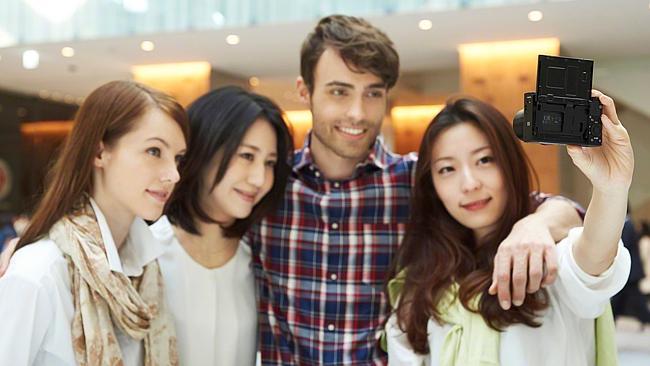Panasonic, Samsung, Sony and Canon design cameras for the selfie obsessed
It’s the annoying craze no narcissist can resist. Now camera manufacturers are aiming directly at the selfie-obsessed.

The selfies craze is gathering more momentum and revelling in its narcissistic splendour.
Instead of being a smartphone fad, now serious camera makers are bowing to the craze by adding selfie modes to up-market compact system cameras.
They’re also programming these cameras to perform cartwheels so selfie devotees don’t have to press the shutter button to take a majestic self-portrait. Getting to the shutter button while smiling (or grimacing) has been the bane of selfie photographers.
Unlike phones, mirrorless or DSLR cameras don’t have an additional front-facing camera for selfies, so manufacturers perform a Houdini act to make it happen. They are putting the camera’s LED screen on a hinge so you can turn it a full 180 degrees and frame yourself for a snap, just above the lens.
The selfie revolution, however, is hitting speed bumps. Organisations are banning selfies and selfie sticks for a raft of reasons. The ban on selfie sticks at the Australian Open last summer, for instance, was predicated on them distracting players.
In the US, with summer around the corner, there’s concern about safety. A spate of US tourists in national parks snapping selfies with bears (with their backs turned to the bear) has led to a ban at California’s Lake Tahoe. A Twitter or Instagram search for #bearselfie will uncover scary photos among an array of lovable stuffed-bear selfies. Fortunately, some #crocselfie snaps that I went looking for were from museums.
Last year, a British man was fined more than $4200 for snapping a selfie in front of charging bulls during annual revelries in Pamplona, Spain. The dangerous selfie is indeed a modern-day dare.
But there are also concerns about cultural taboos and public decency. Last month Thailand announced a ban on so-called “underboob selfies”, whereby people point a camera upwards at the underside of their breasts. The penalty is five years in prison.
Selfie sticks are a problem, too. They have been prohibited at music events in Britain, and the upcoming Lollapalooza and Coachella Valley music festivals in the US, because of concern about recording rights, pirate filming and the physical nuisance selfie sticks create. South Korea’s ban is out of concern that someone could steal phone data through a Bluetooth link connecting a phone and the stick’s trigger.
If you’re a selfie fiend, all is not lost. Late last year the National Gallery in Canberra lifted a photography ban, including of selfies, so if you want to snap yourself in front of works such as Jackson Pollock’s Blue Poles, you’re in luck, although flash photography remains prohibited.
None of this has stopped camera makers steaming ahead with sophisticated selfie snappers.
Last month Panasonic announced the launch of the Lumix GF7, a compact camera designed especially for selfies. It has a 180-degree touch screen monitor, plus built-in modes that automatically take the shot when the camera is out of arm’s reach or when you are using a selfie stick. Set the GF7 to “face shutter” mode and it will trigger the shutter automatically when you wave your hand in front of your face.
“Buddy shutter” will trigger a photo automatically when the camera detects two faces next to each other. The camera takes the shot immediately, or after a three-second or 10-second countdown.
There are also special selfie picture settings, such as “beauty”, “slimming” and “soft skin” modes. A “defocusing” mode will snap you in sharp focus but with the background blurred. (Who cares that you’re standing in front of the pyramids, right?) There are even online guides and e-books on how to take the perfect selfie.
Sony, a long-term maker of “proper” cameras and smartphones, has upped its selfies range with two new cameras, the RX100 M3 ($1099), a cybershot camera with 4K still image output, and the A5100 ($899), a small interchangeable lens camera. Both have 180-degree tiltable LCD screens and the A5100 offers a soft-skin effect.
Canon has included a flippable selfies display on its premium PowerShot model, the PowerShot G7X ($882) and on a cheaper entry-level model, the PowerShot N2 ($385). And recently Samsung announced the NX 500, a small camera with a lens kit that takes selfies.
One thing is certain. The selfie culture isn’t going away. I just wonder what our descendants in 200 years will make of us should they uncover old USB flash drives brimming with self-obsessed grinning humans.
* * *
There’s more to Samsung’s NX 500 than selfies with its flippable 3-inch AMOLED display. The NX 500 is a small sized detachable lens camera with an antique faux-leather finish, yet it is a fully featured mirrorless camera.
I have been trying out the NX 500 and it has the same 28 megapixel APS-C sensor and image processor as the larger NX 1 released last year. Its burst mode is less than the NX 1, 9 instead of 15 frames per second.
It doesn’t have a viewfinder; you have to make do with its touch sensitive display. That won’t worry many, but it will bother those with reading glasses who are used to seeing sharp images through a viewfinder without glasses.
The NX 500 takes extremely good ultra-high definition (4K) video at up to 25 frames per second. It goes on sale this month with a detachable lens kit for $999.


